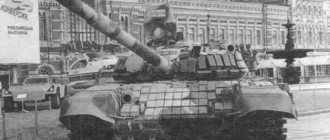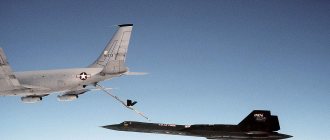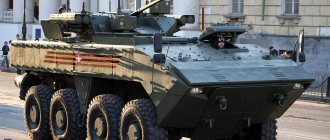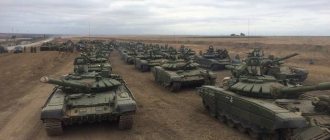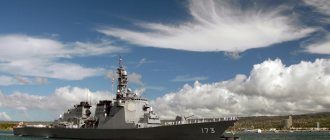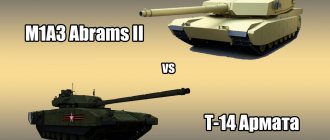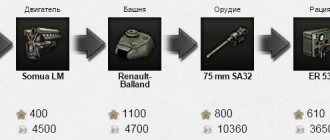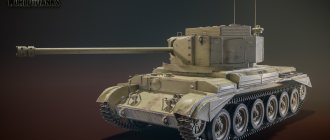No matter how many tanks are buried, they will definitely be in our bright future, and will be for a very long time. At least half a century. After all, thick armor is always better than no armor.
The current situation in tank building is very interesting. Many old solutions no longer work; new types of military conflicts, new types of weapons and defense are emerging. All this can dramatically change the entire approach to armored vehicles. But what exactly the tanks of the future could be like—that’s what we’ll talk about.
"Armata" and competitors
What do we mean by a tank now? A vehicle with a small crew, thick armor and a large cannon. In fact, nothing new can be offered here since the 80s. Active protection systems (APS) have become a little more modern, and that’s all.
The supertank of the 80s “Object 477” is not very different from the “Armata”
The concept has not changed: a meter of combined armor, a 140/152 mm gun, possibly an additional automatic cannon. The advantages of this monster are clear at first glance - any machine that is not similar to it will be destroyed.
It seems that this is it, this is where we need to go.
But the main battle tank (MBT) has a lot of problems. Such an armored unit is a complex and expensive pleasure. The price tag approaches the cost of a good aircraft, the dimensions are growing by leaps and bounds. Already the weight of current combat vehicles easily exceeds 60 tons. But I also want to install dynamic protection (RA), and a drone launcher, and much more. A little more, and the 100-ton mark will be reached.
It is clear that this does not suit anyone. Such a tank would be a horror for a logistician, and tactical mobility would suffer.
The deep modernization of the American Abrams already weighed more than 70 tons. And if you hang a KAZ on such a car...
All attempts to find a solution and overcome the crisis have failed. Design bureaus around the world have tried a lot of options: two-gun vehicles, crazy ones, with a crew of two or even one person. Attempts to install liquid explosive guns or electromagnetic guns on tanks also failed. The projects of tank designers leave far behind any imagination of artists and game makers.
“Object 490” is one of the attempts to find a breakthrough layout for the tank of the future (photo: Source)
Of course, you can build such supertanks in a small series and hope that each of them will destroy at least ten opponents. But in reality everything is different. Even in low-intensity conflict, quantity often trumps quality. So what if in one of the directions you had a super tank that defeated everyone, if there wasn’t enough “armor” in other areas and your infantry was crushed there. The military understands this well, which is why in Britain, the birthplace of the tank, they cry: “Cambodia will have more cars than we have!”
BMP: “don’t shoot at me, I’m not a tank”
If an ordinary tank is at a dead end, how about a radical approach to the problem?
These one-sided breakthrough machines are consigned to the dustbin of history! The future is multitasking.
Let the MBT be replaced by the BMP.
No matter how cynical it sounds, infantry walking along with their vehicle is an additional element of protection, often more effective than armor of any thickness or the most modern KAZ. The infantry adapts to any terrain and can use heavy weapons that are dangerous even for the most monstrous MBTs.
BAE Corporation is now actively working on similar infantry fighting vehicles (photo: BAE)
The BMP in this combination will change a little - a little more armor, better active protection systems. The weapon is a 40/60 mm automatic cannon, capable of hitting even some old tanks head-on.
The main weapon, of course, is anti-tank guided missiles (ATGMs) - the most modern, not even the third, but the next generation. With its own simple intelligence, the ability to fire at invisible targets, when the missile itself will search for the enemy. With versatility - before launch, it will be possible to change the warhead to kinetic or thermobaric, depending on the situation. It will probably be something more like a tactical missile in a vertical launcher.
Alternatively, you can even leave the tank gun and turret. Project of a heavy infantry fighting vehicle based on the Ukrainian T-84 (photo: Source)
It would be reasonable to install a couple of drones on such an infantry fighting vehicle and equip the squad commander’s workplace with augmented reality in the vehicle.
The combination of “an armored car and a modern infantry squad” - perhaps in exoskeletons - will be very strong. But the problems with infantry fighting vehicles are very similar to super-MBTs. Not very modern armored vehicles - such as the thirty-ton Bradley and Marder - have caught up in weight with the medium tanks of the Second World War. And modern armored cars T-15 and Puma have caught up with the heavy IS-2. And they shoot at infantry fighting vehicles like they shoot at tanks - with RPGs and ATGMs. And the weight of the promising machines described above also approaches the hundred-ton mark. In addition, the size exceeds the giant “Mouse”! It is clear that the cost of armored cars is not even close to low. Even rich Americans will not be able to transfer all the infantry to such monsters.
How to transport such colossuses is also not very clear.
So the old Pentagon Wars joke about the creation of the Bradley is really getting old. Bradley doesn't seem so big anymore.
Tanks of the future
Currently, both foreign and Russian specialized publications devoted to the achievements of the modern military-industrial complex and promising types of weapons pay much attention to the analysis of the state of modern armored vehicles, in particular main battle tanks, and the ways of their development. The main question of interest to military theorists is quite simple - what should the tank of the third millennium be like? - but it is quite difficult to answer this question unambiguously, since it requires the analysis of a large number of interrelated factors. Below is a look at this problem from the point of view of the main combat properties of the tank - its firepower and security. Firepower The tank's capabilities in detecting and destroying standard targets will increase significantly. The problem of effective detection of small camouflaged targets in normal and difficult visibility conditions will be solved. The current limitations in this regard reduce the tank's high potential for hitting targets. The tank of the future, within a few fractions of a second (0.85-0.9 s), will be able to detect with great accuracy all threatening and vital targets, both in a stationary position and on the move, in conditions of good visibility and at a direct shot range ( 4000-5000 m). The tank will retain similar capabilities at relatively shorter distances (2500-3000 m) in adverse conditions: in the dark, fog, rain, dust, etc. In a word, the tank will become an all-weather weapon, capable of operating reliably at any time day and night. This can be achieved through the integration of surveillance and automatic search systems operating in a wide range of electromagnetic waves: optics, thermal imagers, low-level IR surveillance devices, radar operating in the millimeter range, and an on-board computer capable of identifying targets by many characteristics, including according to their specific signatures. A generalized picture of the target appears on the display screen. The tank commander takes an active part in target acquisition using a sophisticated fire control system. The improved main weapons will retain their combined nature. This will be an ATGM launcher fired through the barrel. This combination will retain all the advantages of cannon armament (which remains uncompetitive at ranges up to 2500 m) and will allow the tank to hit armored targets at ranges up to 5000 m. The caliber of the tank gun will increase to 140-155 mm, and its ballistic characteristics will also improve (pressure 6500-7500 kg /cm2) with a slight increase in weight. The bore will remain smooth, thus providing a lightweight and durable barrel design with high ballistic performance. The 140-155 mm caliber will increase the armor penetration of hyper-velocity armor-piercing projectiles, the damaging effect of cumulative projectiles and the ability of high-explosive fragmentation projectiles to destroy tanks through an impulse effect, without even penetrating armor, and also create volumetric explosion ammunition that is highly effective when used against enemy personnel (even stationed in shelters) and armored targets. The hyper-velocity armor-piercing projectile will remain the main means of destroying armored targets. Its destructive power will increase many times thanks to the high initial speed and the use in the core of a rather heavy (19.5 g/cm3) and powerful (single crystal) element made of depleted uranium with an increased length-to-diameter ratio. All projectiles with a cumulative warhead will have a tandem design, which will allow them to penetrate active-reactive armor barriers. Since the tank is a multi-purpose weapon, its ammunition load must include at least 50% armor-piercing shells. The rest of the ammunition should consist of universal ammunition that retains armor-piercing ability, which will allow them to effectively destroy manpower and lightly armored targets. Such projectiles - cumulative fragmentation or high-explosive fragmentation - can explode along the flight path, throwing forward a stream of fragments, since these projectiles and their ballistic characteristics will be programmed depending on the nature of the target. The tank can also use liquid propellants, which increases the amount of ammunition it can carry. Due to their low-molecular composition, such substances will be able to significantly enhance the efficiency and accuracy of hyper-velocity armor-piercing projectiles (due to an increase in initial velocity) and will allow programming the ballistic characteristics of universal projectiles.
Promising engineering developments suggest increasing the armor-piercing ability of hyper-velocity armor-piercing (kinetic) and cumulative projectiles to 1000-1200 mm. However, the absolute ability to hit tanks is hardly achievable. The competition between armor and projectile will continue. Since the capabilities of hyper-velocity armor-piercing and cumulative projectiles are approaching the limit, high-explosive projectiles of 140-155 mm caliber seem very promising. Despite the transition to this caliber, the number of rounds in the ammunition load will remain at the level of 40-45 (when using conventional propellants) thanks to the new ammunition stowage system. Through the use of liquid propellants, the ammunition load can be increased to 60-65 rounds, and this will be sufficient, given the increased lethality of the ammunition.
The automatic loading mechanism will become an integral part of the weapon system of the future tank. The use of liquid propellants will simplify the design of the automatic loader and make ammunition racks more compact. High shooting accuracy will be ensured by a standard two-plane stabilization system with electric drives, an independent aiming line and a digital ballistic computer with sensors that calculate the distance to the target, its speed, trunnion angle, wind direction and strength, temperature, atmospheric pressure, etc. Tank An optical rangefinder will be required to measure the distance to a target that does not have vertical projections, such as a shooting cell. It is likely that in the near future there will be a system that provides precise automatic targeting of a selected target and tracking it while it moves and maneuvers the tank itself. The performance of the stabilization system will be greatly improved thanks to the controlled body stabilization system. The probability of hitting the target when shooting on the move will be 80-85% compared to shooting from a standing position. A similar fire control system will ensure sufficiently high accuracy of shooting at small targets with ballistic projectiles (the probability of hitting a target is 0.85 at a range of up to 2500 m). At greater ranges, it is necessary to use guided weapons that provide a probability of destruction coefficient of 0.9. The development of guided weapons requires rapid action, further improvements in laser beam guidance and the creation of homing warheads that focus on the image of the target rather than its general silhouette. This will prevent you from falling into various traps, will allow you to apply the “fire and forget” principle and minimize the difference between the accuracy of shooting on the move and from a standstill. The introduction of a programmed flight path of a missile with guidance in the final phase will make it possible to hit enemy tanks on the roof, which is less reliably protected. Despite all the advantages of guided weapons, in the foreseeable future they will remain the most effective addition to cannon weapons, reliably “fighting small targets with vertical projections at ranges from 500 to 2500 m. Most targets (up to 70%) are at a range of up to 2500 m and can easily be hit by a weapon with high ballistic characteristics. As for air targets, the fight against them should be carried out jointly with ZSU and infantry fighting vehicles. As a consequence of this, future tanks will retain only light anti-aircraft weapons (12.7 mm machine gun or 20 mm cannon), capable of performing only external target designation. Guided tank weapons can also be used to combat helicopters. Protection With the advent of an arsenal of the most modern means of combating tanks, the problem of their protection—a complex and intractable problem—is acquiring particular importance now and in the future. But it can and should be successfully solved thanks to new achievements in engineering and scientific thought. Naturally, we are not talking about the absolute invulnerability of the tank. Losses are inevitable during combat operations, but it is important to keep them within reasonable limits, beyond which any successful military operations on the front line may become impossible. This problem can be solved comprehensively by increasing the individual survivability of the tank, carrying out camouflage measures among the troops, conducting active counterintelligence operations and launching massive attacks on enemy firing positions. It is also necessary to create the required superiority in forces. Tanks of the future will be distinguished by the presence of combined standard equipment, which will radically (by 1.5-2 times) reduce the possibility of their detection by enemy reconnaissance means and destruction by fire weapons. Masking in all ranges of emitted frequencies will be ensured by reducing the silhouette, “smoothing” the shape of the tank, or using covers and various coatings that absorb radio waves and dissipate thermal radiation. In addition, various jammers can be created using aerosols, decoy simulators and electronic warfare equipment.
Increased tank protection against various destructive effects will be achieved through an optimal combination of passive armor protection with active-reactive armor or active protection means and further improvement of these elements. A rational layout will be an important condition for reducing the armored surface and, thereby, the total weight, as well as placing vital elements in the armored space.
Armor protection is constantly being improved due to new design and metal properties, increased weight, optimal differentiation of armor and large angles of its inclination (65°-70°). A characteristic feature of the main elements of armor protection will be a combined multilayer structure - several layers of steel armor with fillers for various purposes between them (these elements may change depending on the prevailing circumstances).
The strength of basic steel armor can be increased using new technological processes, such as reinforcing steel with superstressed carbon fibers. The main component of the combined armor will remain a layer (or layers) of relatively light material with enhanced specific resistance to the action of a cumulative jet. A protective layer containing depleted uranium reliably stops hyper-velocity armor-piercing projectiles; it is no less effective against cumulative projectiles, but its use leads to an increase in the weight of the armor. Built-in reactive armor, the action of which is based on the impact of the explosion effect on a cumulative jet or kinetic projectile, sharply reduces the armor penetration of cumulative projectiles and to a lesser extent affects the armor-piercing ability of hyper-velocity armor-piercing projectiles. Like tandem-type cumulative ammunition, reactive armor should also become tandem. The rapid development of various means of destruction and relative conservatism in terms of armor protection force the use of a modular principle in its design, which consists in attaching protective elements to a supporting base (tank body). These protective elements may change depending on new advances in the field of armor protection or improvements in means of destruction.
Taking into account the data of promising engineering developments, we can expect the use on tanks of frontal armor equivalent in thickness to 1000-1200 mm of homogeneous armor steel, capable of reliably resisting the action of hyper-velocity armor-piercing and cumulative projectiles (tandem type). Thus, the tank of the future will have a fairly high level of protection: its frontal armor will become impenetrable to shells from tank guns, more powerful ATGMs and other ammunition with a cumulative warhead; The side armor will be able to withstand hits from light ATGMs and hand-held grenade launchers, while the hull and turret roofs will be able to withstand hits from small-caliber cumulative ammunition, precision weapon cores and 30-mm aircraft cannon shells. Despite these relatively high figures, the problem remains protecting the sides of the tank from hyper-velocity armor-piercing projectiles and powerful ATGMs and the roof from ATGMs with a programmable flight path and more powerful warheads of precision weapons. Obviously, this problem will be solved with the help of active protection. The principle of active protection consists of radar detection of approaching weapons and their subsequent destruction by fire from small grenade launchers (or other weapons) mounted on the tank. Due to limited ammunition, active protection should be used mainly against those enemy weapons that the tank's armor cannot protect against. Only active protection can solve the extremely complex problem of reliable tank protection from the dynamic effect of powerful high-explosive shells, large-caliber kinetic shells and volumetric explosion ammunition. Only the complete destruction of such shells at a safe distance from the tank can ensure its survival on the battlefield. The problem of mine protection for tanks should be solved by engineering troops, as well as by attaching mine trawls to tanks. Remotely controlled detection systems can be used against certain types of mines. When taking measures to protect tanks, it is very important to reduce the number of damaged combat vehicles, as well as the extent of their damage, so that they can be restored in the field and returned to service as soon as possible.
This problem will be solved through the use of a rational internal layout and a number of measures to localize damage in the armored space of the tank: the use of anti-fragmentation lining, armored compartments for fuel and ammunition, the protection of fuel tanks (including with the help of inert gases), the installation of knockout panels in the compartments for ammunition storage. The key role is played by the rapid and effective response of the fire extinguishing system. The risk of explosion and fire when breaking through the armor protection of a tank should be reduced several times. Taking into account the general assessment of the expected achievements in the development of means of destruction and protection, we can say with confidence that in the foreseeable future the balance between them will not be disturbed, although a slight predominance of one over the other is possible. In any case, a tank of the third millennium will be difficult to hit head-on even with the most powerful means of destruction. An equally difficult task will be the development of powerful weapons and reliable means of protection against this tank. High tank losses during the Middle East War in 1973 (50% of the tank fleet was destroyed within one week) and during the assault on Grozny, as well as minor Allied losses in the Gulf War (only 18 tanks) are atypical examples. . The problem of protecting tanks from the damaging factors of nuclear weapons should be solved within the framework of general measures to protect against classical means of destruction. Placing the tank crew in a “capsule” will significantly reduce the level of penetrating radiation during a nuclear explosion and the effect of the shock wave without increasing the mass of the tank and its internal volume.
Summing up the above, we can say with confidence that tanks are one of the main means of combating modern warfare, characterized by the possibility of using high-precision, nuclear, chemical and bacteriological weapons. Over a period of just over 80 years, tanks have come a long way: from technically imperfect, slow-moving and clumsy monsters that terrified the soldiers of the First World War, they have turned into constantly improving high-speed, powerfully armed and reliably protected combat vehicles, saturated with computerized systems that allow them conduct combat operations 24 hours a day, in any weather conditions and in any climatic zone.
Despite the predictions of skeptics who claimed that the improvement of anti-tank weapons would put an end to the dominance of tanks on the battlefield, the experience of the Korean and Vietnamese wars, the Indo-Pakistani and Arab-Israeli conflicts and, finally, the wars in the Persian Gulf and Afghanistan convincingly proved the inconsistency of such conclusions and confirmed that the tank still remains a formidable military weapon - the core of the ground forces of all armies of the world, and the development of modern vehicles has led to the fact that the tank has become transportable for all types of transport, including air, which further enhanced its capabilities and significance as a means of struggle. At present, there is not, and in the near future, the emergence of a cheaper and more powerful weapon system that could be comparable to a tank in its characteristics and would be capable of providing high maneuverability, protection from enemy fire, firepower and the ability to operate in any conditions in various conditions is not expected. types of combat.
Like
SocButtons v1.5
Materials in this section posted after the current one:
- 08/31/2010 — The fight that never happened. Continuation.
- 08/31/2010 — The fight that never happened
- 08/27/2010 — Do Russia need tanks?
- 08/24/2010 — Failure of the MVT-2000 tank in Peru: details
- 08/20/2010 — Comparison of modern main tanks
Materials in this section placed before the current one:
- 08/17/2010 — The tank forces of the Russian Federation have degraded: NATO has developed the technology for their destruction
- 09/08/2010 — The global market for new MBTs is expected to grow by about 20% in the next 4 years
- 05/08/2010 — T-90 — the main battle tank of Russia
- 07/30/2010 — World armored vehicles market in 2004-2013.
- 07/27/2010 — Tank duel: T90 vs Arjun
Next material >>
Comments
-2
VANYA December 06, 2013
vanyatankiminkp aft
Reply Reply with quote Quote
Update list of comments RSS feed of comments for this entry.
Add a comment
Glory to the robots!
American promising light tank-robot
It turns out that the BMP is very expensive. Then there is one even more radical option. Throw out of the tank its main “obstacle” - the crew, and a robotic armored unit will come to the battlefield. She doesn’t need serious armor—the loss isn’t that bad. There will be no loud scandal if robots, and not “our guys,” die in distant “Papuasia.”
Saving on armor means we can solve all other issues without any problems. Need a big gun? No problem. You can add more good ATGMs to it. Mobility? Just like in distant and happy times, when tanks were small - after all, our armored vehicle will weigh even less than 30 tons. Any bridges are suitable for us; airlift could not be easier. And with protection, everything is not as bad as it seems. Promising KAZs can even knock down crowbars; meters of steel or combines are not needed. And in the future, maybe more advanced types of protection will arrive - like lasers and electromagnetic active armor.
Many American designers in their projects focus on the development of active protection to the detriment of conventional armor
The main issue, of course, is artificial intelligence (AI). It is clear that for now it will not be possible to create a completely autonomous tank. For starters, you can bet on remote controlled ones. Then the AI will take over the driving, and the shooting will continue to be controlled by a person from a command post, hundreds of kilometers from the battlefield. In the meantime, neural networks will begin to learn military science, as Lenin bequeathed. Thousands of hours on real and virtual training grounds against human commanders and against the same networks. Then you can start transporting robots to hot spots and gaining experience there. Sooner or later the time will come when it will be enough for such tanks to set a combat mission and wait for it to be completed.
You can create such combat vehicles even on old chassis!
It seems that this is the solution! But there are also serious pitfalls here, and this is not the banal danger of the “rebellion of the machines.” This won't happen. But war is an incredibly complex thing. Man continually makes mistakes in war. For example, he decides that those peaceful shepherds over there are a detachment of enemy infantry, and orders fire at them with all guns. A person could at least be jailed for this.
What if a robot demolishes a couple of hospitals because fire was fired from their roof? Plant a robot?
If you turn the restrictions to the maximum, vulnerabilities will appear in the program that can be easily exploited by the enemy. For example, he will train girls to be grenade launchers and send them into battle in civilian clothes. It’s cruel and illegal, but it can work against the most limited combat systems. And it’s scary to even imagine what kind of freedom there will be for electronic warfare (EW)!
We are also working on robot tanks
CATEGORY STUDENTS
First place
"TRUVA"
This project, the result of the creativity of a group of students at Gazi University (Turkey), copies the principle of protecting a battleship: modular armor plates are overlapped at an angle to each other and soften damage to the main armor.
The latter is reinforced with inserts of combined aluminum-ceramic armor on the sides, boron-aluminum composite in the lower belt, and the bottom of the vehicle is protected by layers of armor based on silicon carbide and a blast-damping honeycomb structure between them. Each crew member has virtual reality glasses connected to nine cameras outside the infantry fighting vehicle, as well as to the camera of a quadcopter, which is launched from a special hatch and can conduct reconnaissance of the area.
Switching cameras is done by naturally turning your head. The picture from the cameras is mixed with information about the tactical situation, as well as the state of the infantry fighting vehicle - ammunition, damage, etc. (it is interesting that as an example of such a “tank” interface, a screenshot of the popular multiplayer online game “World of tanks” by the Belarusian studio Wargaming is given .)
In the event of damage to all cameras or the electronics that control them, the mechanical drive has the ability to open the hatch for viewing. The machine provides remote control from a remote terminal.
Second place
„Metçek”
Our review ends with the MetÇek project, the name of which is apparently made up of parts of the surnames of the authors - Mehmet Çiçek (Mimar Minan University) and Mehmet Metin (Marmara University). MetÇek is more interesting visually than technically. Like other projects participants, this is an amphibious infantry fighting vehicle. In addition to the remote-controlled combat module, the vehicle is equipped with a hatch with armored screens, from which, if necessary, the paratrooper can fire small arms.
Source - https://technowars.defence.ru/article/2118/
Old but useful
So in the future, all countries wishing to have a solid tank fleet will have one thing left. It's sad to modernize what we currently have. That is, Abrams with different numbers and T-90 with different letters.
Even from an old T-72 you can make a good modern tank, for example, as in the T-72B2 “Slingshot” project (photo: A. Khlopotov)
But what else is needed for happiness? Races to and from the English Channel have been canceled for now. There is a thermal imager, there is dynamic protection, they install active protection. Slowly and sadly picking at the defenses of various illegal groups and guarding bases with checkpoints will do. And at any time of the day or night.
The Americans are also constantly modernizing their Abrams and are in no hurry to build new tanks
The main problem with this approach is that there is always a danger that someone will have enough money for a sufficient fleet of super-MBTs (or ATGMs) - then all our simple tanks will become completely useless. Or - as already happened in the 60s with smoothbore guns and combined armor - someone will find a way to break out of modern restrictions and be able to create a super tank at a normal price and normal weight.
What should those who have “no money at all” do?
Well forgotten old
Strictly speaking, the idea of creating a universal mechanized unit has been in the air for a long time. The British tried to implement it in the first half of the 20th century, creating an experimental armored brigade (Experimental Armored Force) in 1927. In addition to the tank units themselves, the EAF included reconnaissance units in armored vehicles, field, howitzer and anti-aircraft artillery, motorized infantry, engineers, support and communications. In addition, the brigade was assigned reconnaissance, fighter and bomber aircraft.
The idea was decades ahead of its time, but then its implementation failed due to insufficiently developed technologies, high cost and high requirements for training soldiers and officers.
wheeled_vehicles
Wedge Martel leads a brigade of Mk.II medium tanks
Photo: iwm.org.uk
"Typhoon" in the mountains: scouts will switch to a new armored vehicle
After testing, the equipment will be sent to military units where there are army climbers
In the late 1990s, this idea was returned to the United States, where the development of the ambitious FCS (Future Combat Systems) program began. By the mid-2000s, the US Department of Defense invited Germany, Great Britain and France, as well as NATO partner countries, to participate in Project Scorpion, a multinational program to modernize the armed forces. It is partly for this reason that a number of European “army of the future” programs include recognizable elements originally developed in the United States.
At the moment, the concept of multi-medium wars is supported both within NATO and outside the North Atlantic Alliance. We can say that a new global trend has formed.
It is noteworthy that in most modernization programs the brigade is considered as the main tactical mechanized formation. And, just like 92 years ago in the UK, today's teams have a wide range of capabilities and tools at their disposal.
The list of tactical tasks of brigades includes: control over a certain territory; decisive action in difficult terrain; offensive covering actions (raid, fire raid, deep attack, force reconnaissance); defensive covering actions (containment or defense on a broad front) and ensuring the entry of allied forces into the theater of operations.
Calling fire: a new combat vehicle has been developed for aircraft controllers
The first armored vehicles capable of providing target designation to aircraft have been sent to Syria
In addition, it is assumed that such brigades will be able to destroy the notorious A2/AD “bubbles” - the zones of air defense, anti-aircraft missiles, cannon and rocket artillery and other means that interfere with the access and maneuver of allied forces. The purpose of these actions is to ensure freedom of maneuver at the divisional level.
Shushpanzers on the road of rage
We take thicker armor and weld it onto any chassis we have. Car, armored personnel carrier, tank. Weapons - “uniform eight, what was stolen is what we carry.” From twin ZU-23 and quad ZPU-4 to BMP turrets and even old tanks.
An armored car with an autocannon and a Javelin is already a serious threat even for a tank
We get the classic shaitan-arba. Despite their terrible appearance, the armor of such... uh... products can already reach a respectable 60 mm. Which immediately “zeroes” infantry weapons (except for RPGs and portable missiles), heavy machine guns and most automatic guns.
Howitzer on a jeep like an adult
Those who still have some money - keep Samum. An armored truck with a pair of anti-aircraft guns and remote control. The best thing is against the oncoming Toyotas.
A special subtype is homemade missiles on an armored chassis. He drove up, came under fire, responded with fire, and drove on.
A couple of Hydra rocket launchers on a Hummer turn into a fast and dangerous MLRS
What do you think about the tanks of the future?

